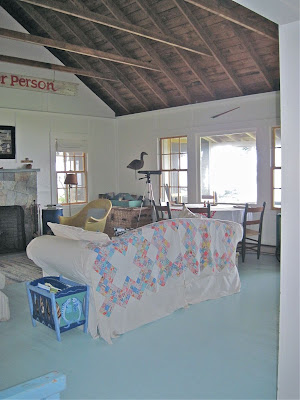Hurricane Irene approached, and we were as ready as we could be for her unwelcome arrival. All the boats were safely stowed and the harbors emptied. Lobstermen worked frantically and hauled out their traps.
The stern of this lobster boat is piled high with traps he is hauling out before the storm.
We piled firewood onto the porch, bought batteries, extra flashlights, a crank radio, emergency candles, a Coleman lantern, and food for ourselves and the birds. We made a final foray to the South Bristol Town Hall and drew our water out of the town artesian spring.
Gamage Shipyard in the Western Gut is empty!
The winds howled. The surf rose and ripped through beds of seaweed, then hurled it onto the rocks. The waves pounded, roared, thundered against the ledges in front of the cottage, and tossed their spume hundreds of feet from the sea.
These rock ledges protect us from the storm surge.
A Mourning dove feeds on black oil sunflower seeds while the waves crash beside him.
Goldfinch riding out the storm and eating
We were uneasy. Would a tree fall on the cottage? Was our car okay parked in the driveway? Would the old Fresh Air Camp, after years of standing on the edge of the sea, finally be engulfed by waves? And what about the birds? The little warblers, thrushes, sparrows, and hummingbirds were migrating steadily above us. How would they fare in this weather?
Watch closely for the hummingbird trying to visit the feeder
By midnight, the shriek of the wind through every crack and crevice in our house was grating. We crawled into bed and stared out at the gray night, lit by the whiteness of the breaking waves. The flash of the Pemaquid Lighthouse (built in 1827) punctuated the darkness every six seconds. Sleep was impossible.
I wandered the house and thought about the birds. Years ago, the Audubon Society had honored me with a scholarship to Hog Island Ornithology Camp in Maine. I got to help with the banding of warblers, caught birds in mist nets, identified migratory species, and learned so much about their migrations (which still remain mysterious and magical to me).
Late these August nights when we are on our walks, I can hear the sounds of the little birds migrating. Although they usually fly at an altitude of 500 feet (and up to thousands), sometimes they dip lower (depending on weather conditions). I hear their peeping, their whistles, their piping calls. They tug at my heart.
I learned long ago when working on the 102 foot Royal Polaris along the coast and lagoons of Baja, California, how birds will fly toward a light and take shelter during foul weather. We would awaken in the morning after a storm and find scores of rare birds perched on lines, cabins, and equipment. This same phenomenon occurs when night migrants see a lighthouse or a strongly lit building. They fly toward the light for shelter.
So last night I turned on the lamp in the window by the sea. The winds blew and tossed the 'Heavenly Blue' morning glory and tugged it from the trellis. And there in its place? A wood thrush, the bird who serenades us with its overlapping songs of "ee-ooh-ee-ooh-lay." This songster has a syrinx, which on us humans would be like having two sets of vocal chords. (Click here for the song of the Wood thrush.) He is able to sing and trill using both sets at the same time. He had seen my welcoming light and fought his way through the winds to a small harbor of peace.
My 'Heavenly Blue' morning glories are torn to shreds and coated with salt spray. The Wood thrush has taken wing and moved on to feed during the daylight hours.
Tonight I'll sleep lightly and send up a prayer in hopes for safety for all the people along the coast and for all the migrating birds wending their way south. Good luck and faretheewell.
Thank you for all your warm and caring e-mails, letters, and comments. We've made it so far and are thankful for the protective ledge of giant rocks in front of our cottage. Until next time, I wish you well.
Sharon
P.S. Won't you stop by for a quick visit to my Lowe's blog posting? This one is about fragrant plants to include in your garden. Please leave a valued comment.








































































